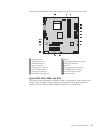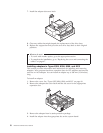
Types
8303,
8304,
and
8312
This
section
provides
information
and
instructions
for
installing
and
removing
internal
drives.
Internal
drives
are
devices
that
your
computer
uses
to
read
and
store
data.
You
can
add
or
replace
drives
to
your
computer
to
increase
storage
capacity
and
to
enable
your
computer
to
read
other
types
of
media
such
as
CD-ROM.
Internal
drives
are
installed
in
bays.
In
this
book,
the
bays
are
referred
to
as
bay
1,
bay
2,
and
so
on.
When
you
install
an
internal
drive,
it
is
important
to
note
what
type
and
size
of
drive
that
you
can
install
in
each
bay.
Also,
it
is
important
to
correctly
connect
the
internal
drive
cables
to
the
installed
drive.
Drive
specifications:
Your
computer
might
come
with
the
following
IBM-installed
drives:
v
A
3.5-inch
diskette
drive
in
bay
1
v
A
CD-ROM
drive
or
DVD-ROM
drive
in
bay
2
(some
models)
v
A
3.5-inch
hard
disk
drive
in
bay
3
Any
bay
that
does
not
have
a
drive
installed
has
a
static
shield
and
bay
panel
installed.
The
following
illustration
shows
the
locations
of
the
drive
bays.
The
following
list
describes
some
of
the
drives
that
you
can
install
in
each
bay
and
their
height
requirements:
1Bay
1
-
Maximum
height:
25.8
mm
(1.0
in.)
3.5-inch
diskette
drive
(preinstalled)
2Bay
2
-
Maximum
height:
43.0
mm
(1.7
in.)
CD-ROM
drive
or
DVD-ROM
drive
(preinstalled
in
some
models)
3Bay
3
-
Maximum
height:
25.8
mm
(1.0
in.)
3.5-inch
hard
disk
drive
(preinstalled)
Notes:
1.
Drives
that
are
greater
than
43.0
mm
(1.7
in.)
high
cannot
be
installed.
2.
Install
removable
media
(tape
or
CD)
drives
in
the
accessible
bay
(bay
2).
Installing
a
drive:
To
install
a
CD-ROM
drive
or
DVD-ROM
drive
in
bay
2,
follow
these
steps:
1.
Remove
the
cover
(see
“Removing
the
cover”
on
page
40).
2.
If
the
drive
you
are
installing
is
a
removable-media
drive,
remove
the
bay
panel
from
the
front
bezel.
Chapter
5.
Installing
Options
53


















